Last year I had the good fortune of spending over a month in Europe. This trip consisted of ten days of solo travel through Madrid and Salamanca, a week with a girlfriend in Barcelona, and two weeks in Italy with my husband Jack. As this epic journey drew closer, one of my coworkers (who is originally from Austria) asked me what type of travel bag I planned to bring. I told her that I assumed I would have to bring a large suitcase since I was going to be gone for so long, visiting a variety of locations and climates. However, as an experienced solo traveler, she strongly advised me to pack light: “The last thing you want is to be struggling alone with a heavy bag on a crowded European train.” This terrifying image stayed with me and I was determined to find a way to pack for a month in a carry-on.
I did a ton of research and decided to purchase the Farpoint 55 Travel Backpack from Osprey, offered for $150 on Amazon. I ordered it in S/M (it also comes in M/L) – this was the perfect size for me (I’m 5’4″). Its volume is 55L (3,400 cubic inches), which complies with carry-on standards. The straps are adjustable, so it was easy to get a perfect fit on my body. It also comes with a removable day pack, which was great for hiking and various day trips. I easily fastened a small combination luggage lock to the main compartment zipper so that I could wear it on my back and not stress about getting robbed. I was incredibly pleased with this bag and will continue to use it on my travels.
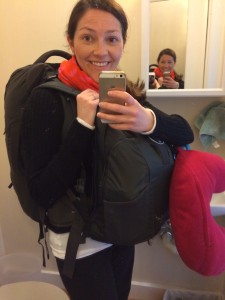
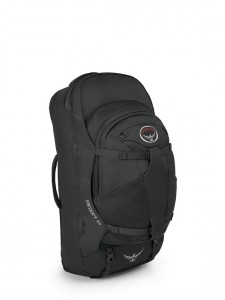
I did a lot of research on how to pack minimal articles of clothing, while maximizing outfit options (thank you, Pinterest!) Here are some of the tips that worked for me:
- Clothing: choose a color scheme (one bold color, the rest neutral like white, black, khaki) so that all your clothes match each other. I picked bright pink as my bold color (though I did include a bright yellow top that matched well). I also tried to pack clothes that do not wrinkle easily (synthetic fabrics work well). I did pack a small bottle of wrinkle releaser just in case.
- Shoes: pack no more than 3-4 pairs of shoes. I packed brown leather Keen Sienna Mary Janes (walking shoes – I also packed ankle socks to keep these shoes as fresh as possible), black Nike Free sneakers (hiking/exercise shoes), gold Sam Edelman thong sandals (“fancy” sandals to wear out, often with dresses), and black Haviana flip flops (for the beach and questionable showers). I tested all of these shoes out before my trip, so I knew they were incredibly comfortable and versatile. I pack them into shoe bags, and I stuff dryer sheets into them if they get stinky along my travels.
- Something New: if you have the money to spend, I highly recommend buying some new clothes for the trip. You are going to be so sick of wearing these clothes by the end of your trip, so you might as well start with some items you aren’t already sick of. Choose your bold color, then make a trip to your favorite clothing store. I ended up packing one pair of capri pants, two skirts, three dresses, two neutral tank tops, four printed tops, two thick cardigan sweaters, a light cotton long-sleeved top, and one chambray top for my everyday wear – this gave me plenty of options during my month abroad.
- Something Old: after I posted this blog post on Facebook, a couple of friends suggested bringing old clothes on vacation, especially for outdoorsy/hiking trips. Such a great idea!
- “My husband’s signature packing secret is that he brings clothes that are on their last legs (socks with a hole in them, etc.) and then he throws them away as he goes, so his pack gets lighter. It’s kind of smart/amusing, but I don’t like my only clothing options to be so haggard. Plus sometimes the clothes don’t make it as far as they’re supposed to – I’ll never forget when his sneaker fell apart when we were in Tokyo and we had to go to like 12 different stores to find somewhere that carried shoes big enough for him!”
- “I do this for when I travel to outdoorsy places – like hiking in Kauai! My husband and I always take and throw away our “done” sneakers and clothes that get stained on the trip – room for fun items to bring back!”
- Accessories: whenever I travel overseas, I leave my engagement ring at home and just travel with my wedding band. As far as other accessories and jewelry, I keep it really simple and colorful: I packed one gold necklace, two brightly colored (pink and green) pairs of earrings from Kate Spade, one pair of dangly purple stone earrings, and a large orange and pink scarf from Stella & Dot (that could double as a blanket on long flights/train rides).



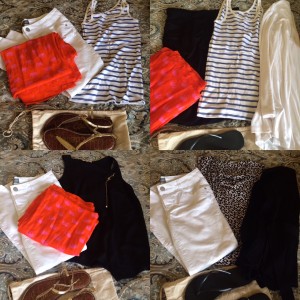
- Packing Cubes: this is a great way to organize your clothes within your bag/suitcase. I purchased several packing cubes from Eagle Creek – I like the clear ones, so you can easily see what you’ve packed inside. One of these can also double as a pillow on your flight (I actually threw away my neck pillow the minute I arrived in Madrid – totally unnecessary). For a bit more money, you can purchase the compression cubes, which zip down to save you extra space. Eagle Creek also makes garment folders to keep button-down shirts (mostly) wrinkle-free – I picked up a couple of these for Jack. Another option (suggested by a well-traveled friend) is to roll your clothes up into individual outfits – then you don’t have to rifle through your bag to find what you need. Bring 6-7 outfits and wash between wears.
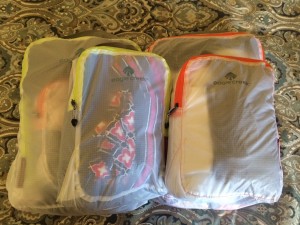
- Jacket: I was visiting Europe in late spring/early summer, so I needed a light water-resistant jacket for possible rain and chilly nights (Madrid and Salamanca cool off at night due to the altitude). In preparation for my trip, I ordered 10+ jackets from Nordstrom and Bloomingdales, but none of them were exactly what I was looking for. I ended up returning everything and going with the perfect Menora rain anorak jacket from Target for $40! If you’re traveling somewhere hot, you could probably get away with a really light compact rain jacket. I’m not sure how I would pack for really cold winter weather in such a small bag; one of my close girlfriends just climbed to Mount Everest Base Camp (she’s amazing!!), and she was able to rent a warm jacket for her trek, rather than lugging her own jacket with her for her entire time abroad.

- Swimwear: I brought ONE bathing suit. One. My cover-up was a cotton skirt and tank top that I could wear as regular clothes. I brought a visor (which Jack made fun of the whole trip) – it was perfect for hiking, exercise, and the beach! I also packed a small tote bag (for beach, shopping) and a large quick-dry towel (I needed my own towel for the student apartment in Salamanca). I made the mistake of washing this bright green towel with my whites in Barcelona, turning many of my white clothes gray halfway through my trip.
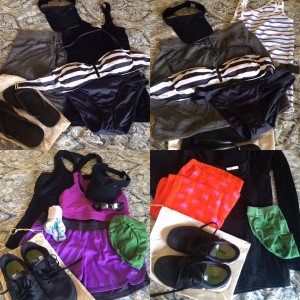
- Undergarments and Laundry: I brought quick-dry underwear from Patagonia and Hanky Panky. This worked out well, as I was able to wash these undergarments in the sink of my hotel and small washing machine of my vacation rental/apartment, then air dry them overnight. I packed detergent sheets, a clothesline, and rubber sink stopper so that I could wash and dry my clothes wherever I was staying. A friend also recommended this laundry kit. I also bring some (totally toxic) dryer sheets in a baggie to stuff into my shoes if they need to “freshen up” along the way.
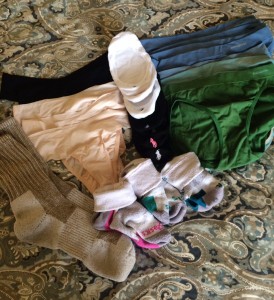

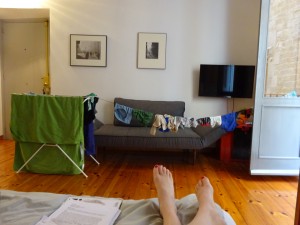
When traveling to a European country like Spain or Italy, it is important to remember that you can buy many of the toiletries you need once you get there. But it’s nice to have what you need for the start of your trip; as you get more comfortable in this new country, you can pick up what you need along the way. Just remember the TSA liquids rule: 3.4 oz containers of liquids, and containers must fit in a one quart plastic bag. I will admit that I had 2-3 of these plastic bags in my carry on during this trip, and TSA did not seem to have a problem with that. Also take a peak at the TSA list of prohibited items.
- Eye care: for those of you with corrective lenses like myself, this is one of those areas that creates some anxiety, as prescription glasses and contact lenses are not as easy to replace as, say, toothpaste when out of the country. Be sure to pack your prescription glasses, contact lenses, multi-purpose contact lens solution (I leave the Clear Care at home, since I don’t always have 6+ hours to soak my contact while traveling), contact lens case, and eye drops. If you use daily disposable contact lenses, consider using one-month lenses for your trip to save valuable space in your suitcase. My prescription glasses are transitions, so I can wear them in the sun without going blind; this saves space (no prescription sunglasses), and is a good backup if I ever had an eye infection that prevented me from wearing my contact lenses.
- Dental care: I packed four small disposable toothpastes for my trip, then threw each tube away after it was used up. I hate to be so wasteful in my everyday life, but this strategy works well on long trips. You can of course purchase toothpaste once you reach your destination, but if you are loyal to a specific brand, this may be a good strategy. Also be sure to pack a toothbrush (I usually use a Sonicare at home, so a soft toothbrush works for me) and dental floss. And don’t forget to bring your mouthguard if you wear one.
- Skincare: I learned the hard way that it is really important to bring your expensive face lotion on long trips. I have really sensitive skin, and I broke out in a rash after using cheap hotel lotion on my face for too many days in a row. The same goes for facial sunscreen. Make room for this in your bag and your face will be happy. As for body sunscreen, this can be purchased on your trip, since you’ll likely need more than 3.4 oz, but expect to pay a premium if you are buying it in a touristy beach location.
- Shower Essentials: if you prefer to use a specific brand of shampoo and conditioner, fill multiple 3.4 oz bottles and throw each one out as you use it up (or you may be able to smash them flat and travel home with them, depending on the bottle). I don’t really care what shampoo I use, so I tend to pack conditioner only. Body soap is usually provided by your hotel, but in a pinch you can use shampoo. I also don’t pack shave lotion/cream, as I can easily use shampoo, soap, or conditioner for this purpose. You can even pack an all-in-one liquid soap to serve all of these purposes. I always pack my razor, but I only bring one blade.
- Hair Stuff: don’t pack a hair dryer, as your hotel or vacation rental will likely have one available. I always bring a diffuser “sock,” as it fits on most hair dryers and helps to get my curly hair voluminous. I don’t recommend packing a curling iron or flat iron, as it takes up a lot of space; however, when I was in Barcelona last year, I caved and purchased a €20 curling iron to get me through my trip. I left it at the hotel in Rome before I returned to the States. If you can style your hair without hot tools, I recommend investing in an anti-frizz serum so you can wear your hair au naturale and save valuable space in your carry-on.
- Makeup: if you wear makeup, pack whatever you need. This is one of those items that is very individualized and it may be difficult to get exactly what you need overseas. When I was in Barcelona, I decided to try to purchase the Clinique lotion I left at home, but it was ridiculously expensive (I asked Jack to bring it from home since he was meeting me in Italy). My recommendation is to pack the minimum amount that you need (one lipstick, one eye shadow compact, etc.) Also be sure to pack tweezers, nail clippers, and an emery board. And don’t forget your chapstick!
- Feminine Hygiene Products: this can definitely be purchased overseas, but if you know you’re going to need it early on in your trip, I recommend bringing applicator-free or “pocket” tampons as they take up very little space.
- Medications: be sure to pack your regular meds, as well as anything you may need for your trip (bug spray/lotion, altitude sickness pills, prescription antibiotics for travelers diarrhea, sleeping pills). I always call the travel nurse offered through my insurance before I travel abroad to find out what vaccinations I need ahead of time and what meds I should bring with me. Be sure to pack over the counter meds and first-aid items that you may need such as ibuprofen, Tums, anti-diarrheals, electrolyte powder (for strenuous activity, altitude), sea sickness meds (Bonine), cough drops, Airborne, Benadryl, Neosporin, and Band-Aids.
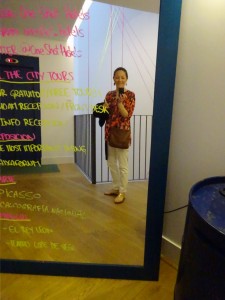


Personal items such as your passport, smartphone, and itinerary are vital to your trip and logistical planning. I’ve learned the hard way to make copies of important documents, and keep the originals locked in the safe at your hotel whenever possible. There are of course exceptions to this rule (Machu Picchu, for example), but for the most part you won’t need your passport while you are exploring the town/city you stay in. I did find that some museums ask for your passport as collateral when renting audio tour equipment, but they should accept a drivers license or passport card in most cases. Some tourist sites will stamp your passport; just make sure it is in a safe compartment in your purse/bag.
- Identification: passport with color photocopy (always store copies in a separate place than the original, in case one gets lost/stolen). I also recommend leaving a second copy with a loved one back home, in case you lose both copies. I also travel with my driver’s license and passport card, though these cannot be used in place of your passport. I also bring a copy of my marriage license since my husband and I have different last names. It’s never been an issue, but it makes me feel comfortable having it with me.
- Credit/Debit: two credit cards and two debit cards (if you have them). You can also leave your debit card in the hotel safe once you get the cash you need from the bank/ATM. Don’t forget to bring any credit cards that will earn you hotel points or airline miles, and/or will get you access into the airport lounge (you will be happy if you have a long layover or your flight gets delayed). Depending on your bank/credit card, you may need to notify them of your travels ahead of time, so your purchases abroad don’t look suspicious (my bank put a hold put on my Visa card while I was traveling abroad in Australia in 2001 – it was a huge inconvenience). Make color copies of the front and backs of these cards so you can easily call to cancel them if they get stolen. I was pick-pocketed in Madrid last year, and the thief took my credit card, debit card, cash, and passport. I now know that I should not have been exploring the city with my passport on me, but luckily I had an extra credit and debit card in the safe at the hotel, as well as photocopies of the ones that were stolen. It as a cinch to call the bank and cancel these cards, and I had an easy way to get access to my funds for the remainder of my trip. (The passport ended up getting turned in by a good samaritan, and I was able to pick it up in Barcelona two weeks later – amazing!!)
- Cash: bring U.S. dollars, as well as the currency of the country you are visiting (you can get this before you leave, or shortly after your arrival). For the most part, I try to use my credit card while traveling abroad, as the exchange rate is better; but it is important to have cash stashed into various pockets of your bag, purse, and clothes (pocket, money belt, etc) for emergencies. Every time I return from a trip with foreign currency, I put the remainder in a labeled baggie and keep it with my travel stuff; so I usually have some cash if I’ve been to that part of the world before. I often order currency from my bank – the exchange rate is a bit higher, but I like knowing that I have enough cash to at least get me from the airport to my hotel when I arrive.
- Purse/Wallet: I wear a cross-body bag that I can keep zipped close and in front of me. When I was pick-pocketed in Madrid, I had taken my camera out of my bag (after a couple glasses of wine…) and forgot to zip it closed. As I was fussing with my camera to photograph a (stupid) fountain, someone reached into my purse and stole my coin purse and passport (which was in a leather case and looked like a wallet). I did not feel anything or notice anyone around me. It can happen in an instant. Rick Steves recommends using a money belt or neck stash wallet, but I haven’t figured out how to make these work with my outfit…
- Smartphone: pack your smartphone, charger, charging case. Turn off data roaming on your phone, and consider getting a global plan from your data provider while you are traveling (call them the month before you leave to learn about options). Many hotels, restaurants, and cafés have Wi-Fi now, so you can easily look at your logistics, email, and social media for free. I used my smartphone a lot while I was traveling alone, especially for directions. You can also download the Kindle app on your phone and reference your guidebook on your smartphone. Rick Steves has some great self-guided tours in his guidebooks, and this is an easy way to access this information without carrying a tablet or guidebook with you as you explore. I also keep a soft copy of my travel itinerary in my email or on Google Drive (you can enable the document to be accessed offline). I also recommend deleting apps and photos you don’t need for your trip to make room for podcasts and music, e-books, useful apps (SpanishDict was very useful in Spain), and all the new photos you will take on your trip!
- Itinerary: bring a printed copy of your travel itinerary and keep an electric copy in your email or Google Drive as a backup.
- Travel plug adapter: remember that an adapter only changes the shape (outlet configuration) of the plug – it does not change the voltage, which varies from country to country. In the U.S., outlets provide 110-120 volts, whereas in Europe it’s 220-240 volts. Electronic devices like laptops, digital cameras, and smartphones usually have built-in voltage adapters; however, hairdryers and curling irons often have a toggle switch so you can manually switch the voltage based on your location. Depending on how many different countries you are visiting, you may want an adapter that works with a variety of outlet configurations. If you have a lot of devices you wish to charge at the same time, consider getting an adapter that has multiple AC outlets and/or USB ports.
Additional items:
- Water and Snacks: I always travel with a leak-proof water bottle, trail mix, peanut butter filled pretzels from Trader Joe’s (the BEST travel snack), and sugar-free gum.
- Sunglasses (and chums if you’re going to be on a boat or somewhere windy).
- Chapstick: I get anxious if I don’t have 2-3 tubes of Vaseline Lip Therapy with me at all times.
- Saline nasal spray for long flights and dry conditions.
- Cleaning Supplies: hand sanitizer, wipes, Kleenex. A friend on Facebook also recommended packing a bandana: “The bandana is so multifunctional and almost always comes in handy. I’ve used it as an emergency napkin, for first aid (tied an ice pack to my ankle), tied up as a sack to hold small loose items, or (if still clean, obviously) as a headband, and even as a tissue when I’ve gotten a runny nose mid-flight.”
- Sleep Gear: bring ear plugs and a sleep mask. I also highly recommend investing in some noise-cancelling headphones. These are pricy, but they have been such a lifesaver for me – they make it easier to hear your music and podcasts on an airplane, and they’ve given me several nights of sound sleep in noisy hotels, or next to a husband who (allegedly) snores. I don’t recommend packing a neck pillow, as a packing cube filled with clothes serves the same purpose. If you find prescription or over the counter meds help you sleep, be sure to pack these in your carry-on.
- Dry Weather Supplies: whenever I travel somewhere dry or overly air-conditioned (like Las Vegas), I bring a travel humidifier. This thing is amazing – just put in a cup of water on your nightstand, plug in the USB, and it will keep your nasal passages moisturized all night.
- Wet Weather Supplies: I always bring a compact umbrella, in addition to a water-resistant jacket.
- Emergency Preparedness: I highly recommend packing a small flashlight, scissors, matches, stain remover, wine key, eyeglass repair kit, and a small sewing kit if you think these items may serve you on your trip.
- E-Reader: pack a Kindle or tablet loaded up with some great vacation reads. Isn’t it amazing how much space we save by not having to pack a bunch of books when we travel? While the Kindle app on my smartphone is great when I’m out and about exploring a town or city, I like the size and feel of the Kindle device when I am reading on the beach or airplane.
- Light Reading: magazines, or some other light reading when you want a break from your novel.
- Travel journal, some good pens.
- Camera: the camera function on most smartphones has improved so much in recent years, that an additional camera may not be necessary. I don’t own an expensive camera, but if I did, I would really have to weigh the risk of having such an obvious piece of expensive equipment hanging off my neck, with the improvement in photo quality. Pickpocketing is unfortunately quite common in Europe – whether you bring a separate camera or not, be sure your valuables are always out of reach of thieves (in a zippered pocket, money bag/belt, in the hotel safe).
For those of us who aren’t natural “minimalists,” it can take a fare bit of planning to pack light. In my case, it was well worth the effort to ensure that I could carry my bag with ease, avoid the extra time of checking a bag, and be confident that I had packed the necessities and ample outfit options. I plan to use this same strategy when I travel to South America later this year!

